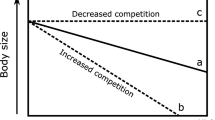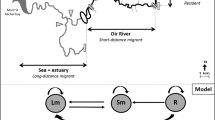Abstract
The effect of predators on prey populations depends on how predator-caused mortality changes with prey population density. Predators can enforce density-dependent prey mortality and contribute to population stability, but only if they have a positive numerical or behavioral response to increased prey density. Otherwise, predator saturation can result in inversely density-dependent mortality, destabilizing prey populations and increasing extinction risk. Juvenile salmon and trout provide some of the clearest empirical examples of density-dependent mortality in animal populations. However, although juvenile salmon are very vulnerable to predators, the demographic effects of predators on juvenile salmon are unknown. We tested the interactive effects of predators and population density on the mortality of juvenile Atlantic salmon (Salmo salar) using controlled releases of salmon in natural streams. We introduced newly hatched juvenile salmon at three population density treatments in six study streams, half of which contained slimy sculpin (Cottus cognatus), a common generalist predator (18 release sites in total, repeated over two summers). Sculpin reversed the direction of density dependence for juvenile salmon mortality. Salmon mortality was density dependent in streams with no sculpin, but inversely density dependent in streams where sculpin were abundant. Such predator-mediated inverse density dependence is especially problematic for prey populations suppressed by other factors, thereby presenting a fundamental challenge to persistence of rare populations and restoration of extirpated populations.


Similar content being viewed by others
References
Anderson TW (2001) Predator responses, prey refuges, and density-dependent mortality of a marine fish. Ecology 82:245–257
Armstrong JD (2005) Spatial variation in population dynamics of juvenile Atlantic salmon: implications for conservation and management. J Fish Biol 67[Suppl B]:35–52
Baker JP et al (1996) Episodic acidification of small streams in the northeastern United States: effects on fish populations. Ecol Appl 6:422–437
Beall E, Dumas J, Claireaux D, Barriere L, Marty C (1994) Dispersal patterns and survival of Atlantic salmon (Salmo salar) juveniles in a nursery stream. ICES J Mar Sci 51:1–9
Benke AC, Huryn AD, Smock LA, Wallace JB (1999) Length–mass relationships for freshwater macroinvertebrates in North America with particular reference to the southeastern United States. J North Am Benthol Soc 18:308–343
Berejikian BA (1995) The effects of hatchery and wild ancestry and experience on the relative ability of steelhead trout fry (Oncorhynchus mykiss) to avoid a benthic predator. Can J Fish Aquat Sci 52:2476–2482
Brannas E (1995) First access to territorial space and exposure to strong predation pressure: a conflict in early emerging Atlantic Salmon (Salmo salar L.) fry. Evol Ecol 9:411–420
Carle FL, Strub MR (1978) A new method for estimating population size from removal data. Biometrics 34:621–830
de Gaudemar B, Schroder SL, Beall EP (2000) Nest placement and egg distribution in Atlantic salmon redds. Environ Biol Fishes 57:37–47
Egglishaw HJ, Shackley PE (1977) Growth, survival and production of juvenile salmon and trout in a Scottish stream, 1966–75. J Fish Biol 11:647–672
Einum S, Nislow KH (2005) Local-scale density-dependent survival of mobile organisms in continuous habitats: an experimental test using Atlantic salmon. Oecologia 143:203–210
Elliott JM (1994) Quantitative ecology and the brown trout. Oxford University Press, Oxford
Elliott JM (2006) Periodic habitat loss alters the competitive coexistence between brown trout and bullheads in a small stream over 34 years. J Anim Ecol 75:54–63
Folt CL, Burns CW (1999) Biological drivers of zooplankton patchiness. Trends Ecol Evol 14:300–305
Folt CL, Nislow KH, Power ME (1998) Implications of temporal and spatial scale for Atlantic salmon (Salmo salar) research. Can J Fish Aquat Sci 55:9–21
Foote CJ, Brown GS (1998) Ecological relationship between freshwater sculpins (genus Cottus) and beach-spawning sockeye salmon (Oncorhynchus nerka) in Iliamna Lake, Alaska. Can J Fish Aquat Sci 55:1524–1533
Gascoigne JC, Lipcius RN (2004) Allee effects driven by predation. J Appl Ecol 41:801–810
Gaudin P, Caillere L (2000) Experimental study of the influence of presence and predation by sculpin, Cottus gobio L., on the drift of emergent brown trout, Salmo trutta L. Arch Hydrobiol 147:257–271
Gephard S, McMenemy JR (2004) An overview of the program to restore Atlantic salmon and other diadromous fishes to the Connecticut River with notes on the current status of these species in the river. Am Fish Soc Monogr 9:287–317
Ginzburg LR, Ferson S, Akcakaya HR (1990) Reconstructibility of density dependence and the conservative assessment of extinction risks. Conserv Biol 4:63–70
Gray MA, Cunjak RA, Munkittrick KR (2004) Site fidelity of slimy sculpin (Cottus cognatus): insights from stable carbon and nitrogen analysis. Can J Fish Aquat Sci 61:1717–1722
Henderson JN, Letcher BH (2003) Predation on stocked Atlantic salmon (Salmo salar) fry. Can J Fish Aquat Sci 60:32–42
Hixon MA, Carr MH (1997) Synergistic predation, density dependence, and population regulation in marine fish. Science 277:946–949
Hixon MA, Jones GP (2005) Competition, predation, and density-dependent mortality in demersal marine fishes. Ecology 86:2847–2859
Hixon MA, Pacala SW, Sandin SA (2002) Population regulation: historical context and contemporary challenges of open vs. closed systems. Ecology 83:1490–1508
Holling CS (1959) The components of predation as revealed by a study of small-mammal predation of the European sawfly. Can Entomol 91:293–320
Johnson DW (2006) Predation, habitat complexity, and variation in density-dependent mortality of temperate reef fishes. Ecology 87:1179–1188
Jonsson N, Jonsson B, Hansen LP (1998) The relative role of density-dependent and density-independent survival in the life cycle of Atlantic salmon Salmo salar. J Anim Ecol 67:751–762
Karels TJ, Byrom AE, Boonstra R, Krebs CJ (2000) The interactive effects of food and predators on reproduction and overwinter survival of arctic ground squirrels. J Anim Ecol 69:235–247
Kennedy BP, Klaue B, Blum JD, Folt C (2004) Integrative measures of consumption rates in salmon: expansion and application of a trace element approach. J Appl Ecol 41:1009–1020
Kocik JF, Ferreri CP (1998) Juvenile production variation in salmonids: population dynamics, habitat, and the role of spatial relationships. Can J Fish Aquat Sci 55:191–200
Le Cren ED (1973) The population dynamics of young trout (Salmo trutta) in relation to density and territorial behavior. Rapports et Proces-Verbaux des Reunions, Conseil International pour L’exploration de la Mer 164:241–246
Letcher BH, Dubreuil T, O’Donnell MJ, Obedzinski M, Griswold K, Nislow KH (2004) Long-term consequences of variation in timing and manner of fry introduction on juvenile Atlantic salmon (Salmo salar) growth, survival, and life-history expression. Can J Fish Aquat Sci 61:2288–2301
Lobon-Cervia J, Rincon PA (2004) Environmental determinants of recruitment and their influence on the population dynamics of stream-living brown trout Salmo trutta. Oikos 105:641–646
Mather ME, Parrish DL, Folt CL, DeGraaf RM (1998) Integrating across scales: effectively applying science for the successful conservation of Atlantic salmon (Salmo salar). Can J Fish Aquat Sci 55:1–8
McMenemy JR (1995) Survival of Atlantic salmon fry stocked at low density in the West River, Vermont. North Am J Fish Manage 15:366–374
Milner NJ, Elliott JM, Armstrong JD, Gardiner R, Welton JS, Ladle M (2003) The natural control of salmon and trout populations in streams. Fish Res 62:111–125
Mirza RS, Chivers DP (2000) Predator-recognition training enhances survival of brook trout: evidence from laboratory and field-enclosure studies. Can J Zool 78:2198–2208
Mirza RS, Chivers DP, Godin JGJ (2001) Brook charr alevins alter timing of nest emergence in response to chemical cues from fish predators. J Chem Ecol 27:1775–1785
Morgan CR, Ringler NH (1992) Experimental manipulation of sculpin (Cottus cognatus) populations in a small stream. J Freshw Ecol 7:227–232
Moyle PB (1977) In defense of sculpins. Fisheries 2:20–23
Murdoch WW, Oaten A (1975) Predation and population stablility. Adv Ecol Res 9:1–132
Naiman RJ, Bilby RE, Schindler DE, Helfield JM (2002) Pacific salmon, nutrients, and the dynamics of freshwater and riparian ecosystems. Ecosystems 5:399–417
Nehlsen W, Williams JE, Lichatowich JA (1991) Pacific salmon at the crossroads: stocks at risk from California, Oregon, Idaho, and Washington. Fisheries 16:4–21
Nislow KH, Folt C, Seandel M (1998) Food and foraging behavior in relation to microhabitat use and survival of age-0 Atlantic salmon. Can J Fish Aquat Sci 55:116–127
Nislow KH, Folt CL, Parrish DL (2000) Spatially explicit bioenergetic analysis of habitat quality for age-0 Atlantic salmon. Trans Am Fish Soc 129:1067–1081
Nislow KH, Einum S, Folt C (2004) Testing predictions of the critical period for survival concept using experiments with stocked Atlantic salmon. J Fish Biol 65[Suppl A]:1–13
Osenberg CW, St Mary CM, Schmitt RJ, Holbrook SJ, Chesson P, Byrne B (2002) Rethinking ecological inference: density dependence in reef fishes. Ecol Lett 5:715–721
Sandin SA, Pacala SW (2005) Fish aggregation results in inversely density-dependent predation on continuous coral reefs. Ecology 86:1520–1530
Schmitt RJ, Holbrook SJ (2007) The scale and cause of spatial heterogeneity in strength of temporal density dependence. Ecology 88:1241–1249
Shepherd JG, Cushing DH (1990) Regulation in fish populations: myth or mirage. Philos Trans R Soc B 330:151–164
Shima JS, Osenberg CW (2003) Cryptic density dependence: effects of covariation between density and site quality in reef fish. Ecology 84:46–52
Sinclair ARE, Pech RP (1996) Density dependence, stochasticity, compensation and predator regulation. Oikos 75:164–173
Sinclair ARE, Pech RP, Dickman CR, Hik D, Mahon P, Newsome AE (1998) Predicting effects of predation on conservation of endangered prey. Conserv Biol 12:564–575
Symons PEK (1979) Estimated escapement of Atlantic salmon (Salmo salar) for maximum smolt production in rivers of different productivity. J Fish Res Board Can 36:132–140
Utzinger J, Roth C, Peter A (1998) Effects of environmental parameters on the distribution of bullhead Cottus gobio with particular consideration of the effects of obstructions. J Appl Ecol 35:882–892
Varley GC, Gradwell GR (1960) Key factors in population studies. J Anim Ecol 29:399–401
Walters CJ, Juanes F (1993) Recruitment limitation as a consequence of natural selection for use of restricted feeding habitats and predation risk taking by juvenile fishes. Can J Fish Aquat Sci 50:2058–2070
Ward DM (2007) Linking density-dependent survival and growth of juvenile Atlantic salmon to their predators and prey. PhD thesis. Dartmouth College, Hanover
Ward DM, Nislow KH, Folt C (2008) Do native species limit survival of reintroduced Atlantic salmon in historic rearing streams? Biol Conserv 141:146–152
Whalen KG, Parrish DL, Mather ME, McMenemy JR (2000) Cross-tributary analysis of parr to smolt recruitment of Atlantic salmon (Salmo salar). Can J Fish Aquat Sci 57:1607–1616
Zanette L, Smith JNM, van Oort H, Clinchy M (2003) Synergistic effects of food and predators on annual reproductive success in song sparrows. Proc R Soc B 270:799–803
Acknowledgments
The authors thank the many people who assisted with field work, particularly Jim Sotiropolous, Gonzalo Mendez, Jon Raffensperger, and Karl Dietrich. Numerous landowners graciously allowed access to study sites. John Armstrong, Matt Ayres, Doug Bolger, and anonyomous reviewers provided helpful comments on an earlier draft. This work was supported by the USDA–USFS Northeastern Research Station, NIEHS-SBRP grant ES07373, an Atlantic Salmon Federation Olin fellowship, and the Dartmouth College Cramer fund. This research was conducted with approval from the Institutional Animal Care and Use Committee at Dartmouth College and conforms to the legal requirements of the United States.
Author information
Authors and Affiliations
Corresponding author
Additional information
Communicated by Craig Osenberg.
Rights and permissions
About this article
Cite this article
Ward, D.M., Nislow, K.H. & Folt, C.L. Predators reverse the direction of density dependence for juvenile salmon mortality. Oecologia 156, 515–522 (2008). https://doi.org/10.1007/s00442-008-1011-4
Received:
Accepted:
Published:
Issue Date:
DOI: https://doi.org/10.1007/s00442-008-1011-4




